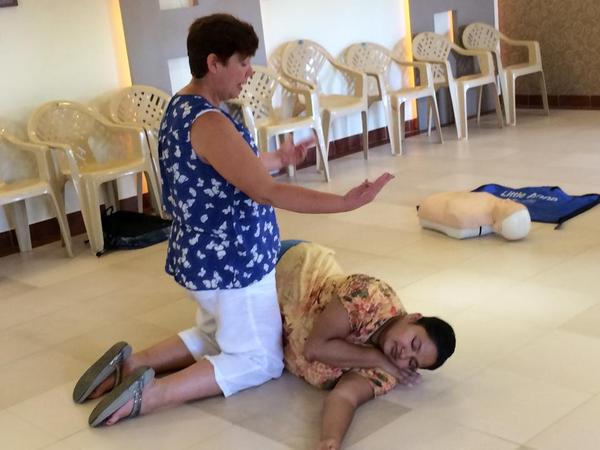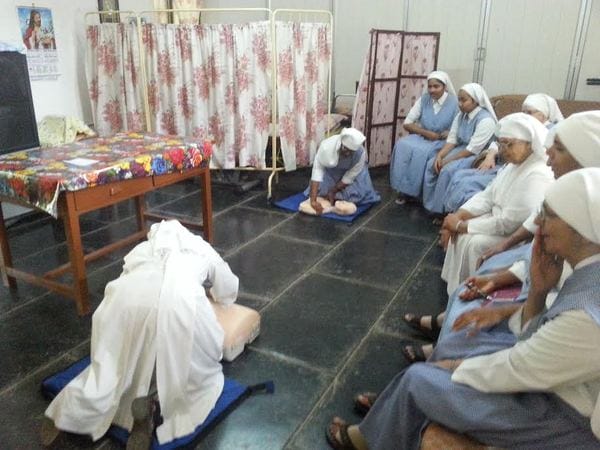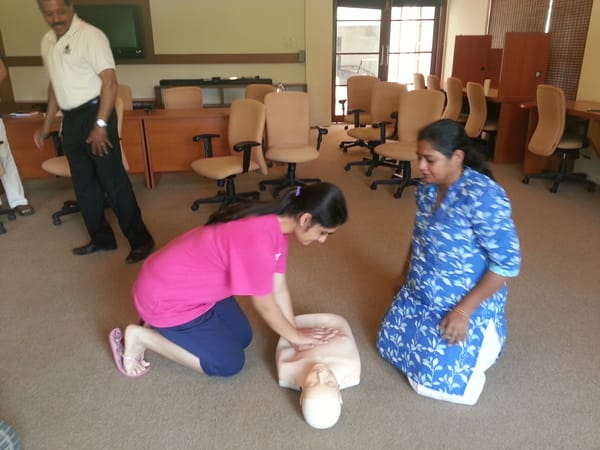Someone in your apartment complex has collapsed. You suspect it is a cardiac arrest and have called for an ambulance. However, you know that the ambulance is going to take a while to arrive, considering the traffic. You also know that the victim needs timely help. What can you do now?
When an individual suffers a cardiac arrest, this is what happens within his body: His heart has unexpectedly and suddenly stopped functioning. This prevents the effective supply of blood, and therefore oxygen to his brain. This also causes him to lose consciousness and stop breathing. If untreated, the lack of blood supply to his brain could lead to severe brain damage and possibly, even death.
This is where CPR comes in handy. If you are trained in CPR, you might very well be able to save the life of a person who has suffered a cardiac arrest. And that is exactly what Paula McLean, a British nurse, currently residing in Whitefield is doing—training residents in the area to deal with medical emergencies.
More than 140 residents trained in CPR since February 2014
The idea of CPR training sessions in Whitefield first came up in February 2014, following the demise of a member of the community due to cardiac arrest. Ritu George, an active member of the Whitefield Rising group, and a friend of the deceased, then began looking for organisations which could help with the training. The thinking was simple—the more the number of folks trained in CPR, the greater the chances of saving a life. Ritu says, “There were several instances of people not getting timely help during a medical emergency in the community, so people were naturally keen on learning CPR.”
The first of the training sessions, a paid one, was conducted by Nightingale Life Saving Services in February and was attended by 15 people. As is the case with most community events that Whitefield Rising organises, a mail was sent to the community with details about the training session.
Paula McLean, a resident of Palm Meadows in Whitefield, happened to come across the mail. An advanced life support instructor for adults, children and babies, and a qualified nurse from the UK with around 25 years of experience in teaching CPR, it was only natural for her to get in touch with Whitefield Rising. She agreed to conduct the training sessions herself, free of cost.
Since then, there has been no turning back and over 140 residents in the Whitefield area have been trained by Paula so far. The last session held at Chaitanya Samarpan Apartments in November 2014 saw a turnout of close to 40 people, including two teenagers. Ritu adds, “Once we started the sessions and word got out, people were reaching out to us to conduct sessions at their community as well.”

Paula McClean with one of her trainees at a session in Whitefield. Pic: Ritu George
What is CPR and why is it useful?
CPR stands for Cardio-Pulmonary Resuscitation. The Mayo Clinic website describes CPR as “a lifesaving technique useful in many emergencies, including heart attack or near drowning, in which someone’s breathing or heartbeat has stopped.”
While CPR alone may not be enough to restart the victim’s heart, it aids in restoring the partial flow of blood to the patient’s heart and brain. This helps in extending the window of opportunity for successful resuscitation of the patient, without brain damage. Simply put, administering CPR can improve the chances of survival for the patient.
Traditional CPR involves compressions and mouth-to-mouth rescue breathing, repeated alternately, till the patient displays signs of responsiveness—facial twitches, breathing, speech. However, experts are of the opinion that untrained lay-persons who are involved in resuscitating the victim, should administer only cardio cerebral or compressions-only or hands-only CPR.
A Time article talks about the case against mouth-to-mouth resuscitation, where studies have proven that ‘when untrained bystanders perform mouth-to-mouth resuscitation on people who are in cardiac arrest, it does not improve patient survival rates.’ Moreover, mouth-to-mouth resuscitation does make the people administering it squeamish, if only because they are worried about contracting secondary infections from the victim.
So what exactly are people trained to do?
The CPR classes are conducted once or twice a month, where around 15 to 20 people attend each session. The oldest trainee so far, has been an 80-year-old nun and the youngest, a 12-year-old girl. Attendees are split into groups, where each group is assigned a mannequin. Ritu says, “In a group environment, people learn from each other. If someone is making a mistake, there’s always somebody who will point out errors.”
Paula teaches compressions-only or hands-only CPR, and starts the class by explaining the theory behind CPR and then moves on to a practical session. By the end of the class, each attendee has had at least four tries administering CPR on a dummy mannequin. While Paula conducts the actual classes, Ritu takes care of the logistics—mobilising people, organising the venue, communicating with interested parties etc. As Nitya Ramakrishnan from Whitefield Rising puts it, “Ritu is the singular reason that Paula can do so much.”

A special training session for the sisters at a convent. Pic: Paula McClean
Paula uses DRS ABC, the acronym recommended by the British Heart Foundation, in her training.
- D stands for Danger. Check for danger and ensure that the patient, as well as those in close proximity, are safe.
- R stands for Response. Gently shake the patient and ask a question in both ears to check if the patient is responding.
- S stands for Shout. If the patient is not responding, shout for help and ask a bystander to dial 108 or call an ambulance.
- If the patient has suffered a cardiac arrest, take suitable action. This is where the latter half of the acronym, ABC, comes in.
- A stands for Airway. Check the airway by opening the mouth and tilting the head back. If the tongue is blocking the airway, the patient will not be able to breathe. Tilting the head back, helps move the tongue.
- B stands for Breathing. Look, listen and feel for signs of normal breathing. If the patient is gasping or not breathing at all, CPR must be administered.
- C stands for CPR. To administer CPR, place the heel of one hand on the centre of the person’s chest. Place the heel on the other hand on top of the first hand and interlock fingers. Press down ‘hard and fast’ on the chest continuously, at the rate of 100 to 120 beats per minutes. The chest should be pressed down between five and six cm in each compression.
Paula says, “It is crucial that there is no break between compressions. For optimal effect, CPR must be administered continuously, without interruptions, for at least two minutes.” The compressions must be continued until the ambulance crew arrives or the person shows signs of regaining consciousness (coughing, blinking, speaking, moving) or until one is exhausted.

Administering CPR is a tiring job. So it works best when there are two people present. If one gets tired, the second can take over – Paula McClean. Pic: Ritu George
Regarding the risks in laymen administering CPR, Paula says, “There is of course the possibility that someone could unknowingly fracture the ribs or sternum of the patient, if they push too hard while administering the chest compressions. But at the end of the day, a broken rib or two is okay, so long as the patient is alive.”
Timely CPR helps save a life
Staying Alive with Stayin’ Alive
According to an NPR report, “A study by the University of Illinois College of Medicine has found that the Bee Gees’ “Stayin’ Alive” has the utterly perfect beat for performing cardiopulmonary resuscitation. The 1977 disco hit contains 103 beats per minute. That’s close to the recommended chest compression rate of 100 beats every 60 seconds.”
Other songs that fit the beats per minute criteria for CPR include the not-so-aptly named, Another One Bites The Dust by Queen, Dancing Queen by ABBA and Man in the Mirror by Michael Jackson. (Source: Medical Futility).
Since February 2014, in addition to conducting CPR classes across communities in Whitefield, Paula has also trained several security guards in Adarsh Palm Meadows apartment, on basic emergency care and CPR. Paula says, “The security guards are the key personnel who are always around. They are the ones who know what is happening in the community. They are among the first ones to be notified about an emergency, and therefore it makes sense to train them.”
She then recounts an incident that occurred earlier this year, where a driver went into cardiac arrest in the early hours of the morning and the security guards, recognising the signs, called Paula immediately. Paula rushed down in her nightgown and with the assistance of another security guard she had trained, administered CPR to the driver till they reached the hospital. The quick thinking on the part of the security and the timely administration of CPR aided in the driver being alive today.
More CPR trainers
Dharmendra Singh, the global head of Mergers and Acquisitions in Schneider Electric is one of those who have attended Paula’s session on CPR. He narrates an incident from his workplace where one of his colleagues suffered a cardiac arrest and there was no one who knew CPR. By the time they got him to the hospital, it was too late.
Dharmendra then conducted a survey at his apartment complex, Prestige Palms, to find out how many people knew CPR, and found out that there was only one such person, who was a doctor. He then reached out to Paula and in September 2014, organised a session at his apartment. In addition to several residents, the session was also attended by the Property Manager and security guard.
Dharmendra says, “Now we know that there are people who can help in case of an emergency. We have put up the names of the folks who can be contacted on the notice board.” He then adds, “While I have so far raised awareness on the importance of CPR in my complex, as a next step, I would like to be able to train folks on CPR. This way, we can ensure that there are more people who can save lives.”
‘I don’t know why I do it. I just do.”
Most hospitals and health-care centres in Bengaluru that offer CPR training, charge a small fee. And considering that it is an extremely useful skill to have, it is certainly worth paying for. Paula however conducts these training sessions free of cost. On being asked what prompts her to do this, she says, “I don’t know. I just do.”
While Paula’s stay in Bengaluru will end in August 2015, when her husband’s tenure in India ends, and they return to the UK, it does not spell an end for the CPR training sessions in Whitefield. Ritu says, “We’re hoping to train at least 500 people in the community before Paula leaves. And from then, we are looking to scale it up further.” In addition, Paula is looking to conduct a couple of ‘train the trainer’ sessions as well, where she will equip about 50 people, who have been trained by her, to train other people in CPR.
Paula is currently in talks with the Rotary Club to arrange for more mannequins for the training sessions. Currently the sessions are conducted with three mannequins, and there is a necessity for more. She also adds that there has been interest from citizens in other parts of the city as well. She says talks are on with a school near Ulsoor Lake to conduct a mass training on CPR for 3,000 children in early 2015, and from here she hopes it will take on a cascading effect.
The need for CPR
In a city like Bengaluru, knowing a skill like CPR could very well be a matter of life or death, especially considering the traffic. Even if one hails an ambulance, there is a chance that it could get stuck in traffic. In light of this, it is essential to remember why a skill like CPR could prove to be useful.
- CPR buys time. It could very well be that window of opportunity that gives the patient enough time that could prevent brain damage or certain death.
- With the roads and traffic conditions in Bengaluru being what they are, CPR could prove as the first port of call in case of an emergency. Even if it takes the ambulance time to arrive, if you are trained in CPR, there is the possibility that you could keep the patient alive till it does.
- With families in cities becoming more nuclear, it is useful if at least some members of the family know CPR.
- In many areas, especially those far off from the city centre where the population is high, there is a paucity of good hospitals. CPR could prove useful in cases of emergency in these areas.
List of CPR trainers in Bangalore
- Whitefield Rising: Hands-only CPR training – hello@whitefieldrising.org
- Narayana Health: AHA certified training – sanjay.b.c.dr@nhhospitals.org
- Nightingale Life Saving Services: nhhs@bgl.vsnl.net.in
- Mercuri Medical
Related Articles
Heart Attack: Are you at risk?
What to do if you have heart disease
Pick and eat to your heart’s content